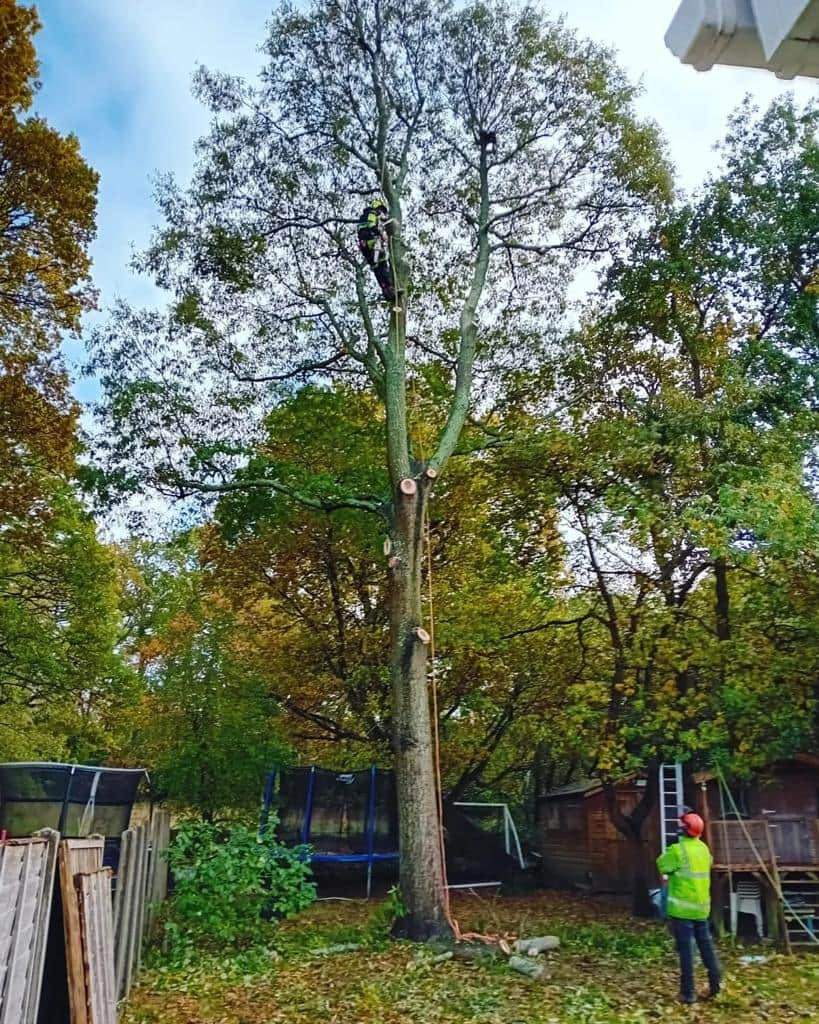When a tree splits or falls, it can cause more than just a visual problem — it can create serious safety hazards and lead to further property or environmental damage if not handled quickly. Whether caused by strong winds, heavy rain, or internal decay, swift and professional intervention makes all the difference in preventing additional harm. At LM Tree Surgery Portchester, we have seen first-hand how taking prompt action helps protect both people and property across Portchester and Hampshire.
Understanding Why Trees Split or Fall
Tree failures often happen suddenly, but the underlying causes usually develop over time. Some of the most common reasons include:
- Strong winds or storms: Sudden gusts place excessive stress on weakened limbs or trunks.
- Structural weaknesses: Poor branch unions or heavy canopies can create imbalances.
- Root problems: Decay or soil disturbance can destabilise a tree from below.
- Neglected maintenance: Overgrown branches or deadwood increase the risk of splitting during high winds.
When a tree finally gives way, the resulting fall or split can pose immediate dangers that require urgent attention from professionals such as LM Tree Surgery Portchester.
Immediate Dangers of a Fallen or Split Tree
Acting quickly after a tree splits or falls isn’t just about aesthetics — it’s about safety. Delaying action can lead to several problems:
1. Safety Hazards to People and Property
A fallen or partially split tree can still shift unexpectedly. Heavy limbs under tension may move suddenly, putting anyone nearby at risk. If the tree has landed on a roof, fence, or vehicle, further damage can occur if it’s not removed safely and correctly.
2. Potential for Secondary Damage
When a tree splits but remains standing, water and pests can quickly invade the damaged areas. This accelerates decay, which may eventually cause the rest of the tree to collapse. In urban and residential areas like Portchester, this can endanger nearby buildings, vehicles, and footpaths.
3. Blocked Access or Obstruction
Fallen trees often block driveways, roads, or garden entrances, creating inconvenience and safety risks. Quick removal ensures your property remains accessible and reduces the chance of further disruption.
The Importance of Professional Intervention
While it may be tempting to clear the debris yourself, split or fallen trees are unpredictable and heavy. Without the right tools and experience, handling them can be dangerous. Professional tree surgeons like LM Tree Surgery Portchester are trained to assess structural integrity, identify potential hazards, and remove fallen trees safely and efficiently.
When responding to a tree emergency, a professional team will:
- Secure the area and assess immediate risks.
- Determine whether the tree can be saved or must be removed.
- Use specialised rigging and lifting equipment for controlled removal.
- Inspect surrounding trees for related stress or damage.
This careful, methodical approach ensures that no further harm occurs during the removal process and that the site is left safe and tidy.
Acting Quickly Can Save the Tree
In some cases, a split tree can still be saved — but only if action is taken promptly. Minor splits or partially damaged limbs may be stabilised with professional pruning, cabling, or bracing techniques. However, time is critical; the longer the damage is left untreated, the greater the chance of infection, decay, or complete failure.
By contacting LM Tree Surgery Portchester soon after the incident, you increase the likelihood of salvaging the tree and preventing irreversible decline.
Preventing Future Tree Splits and Failures
Once a tree has fallen or split, it’s natural to want to avoid a repeat incident. Preventative tree care plays a key role in keeping your garden safe and your trees strong. Regular maintenance can identify early signs of stress and instability before they escalate.
Some effective preventative measures include:
- Crown reduction: Reducing the size and weight of the canopy to improve wind resistance.
- Thinning: Allowing air to circulate more freely, reducing wind drag.
- Pruning: Removing dead or overextended branches that may cause imbalance.
- Tree health checks: Detecting early signs of disease or decay in the trunk and roots.
These proactive steps not only enhance safety but also promote long-term tree health and aesthetic appeal.
Conclusion
A fallen or split tree requires more than a quick clean-up — it demands fast, professional attention to prevent further risks and damage. Acting promptly ensures safety, protects nearby structures, and can even save the affected tree if the issue is addressed early enough.
At LM Tree Surgery Portchester, we provide swift, expert response for fallen and damaged trees throughout Portchester and Hampshire. Our skilled team can safely assess, remove, or restore trees using professional techniques tailored to each situation. Fast action today can make all the difference in protecting your property and keeping your trees healthy for years to come.
Call us on: 023 8235 6058
Click here to find out more about LM Tree Surgery Portchester
Click here to complete our contact form and see how we can help with your tree needs.

